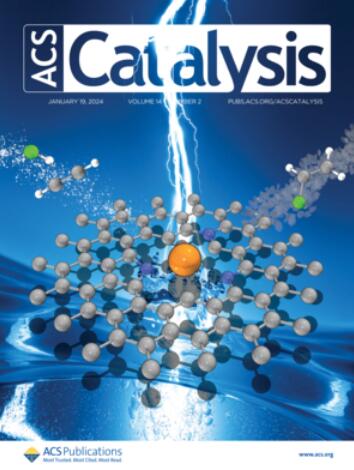氧化钴与氮磷共掺杂碳结合的钌纳米颗粒用于氨硼烷水解脱氢
IF 13.1
1区 化学
Q1 CHEMISTRY, PHYSICAL
引用次数: 0
摘要
开发经济高效的氨硼烷(AB)水解制氢催化剂仍然是清洁能源生产领域的一个重大挑战。在催化剂中可控地引入掺杂剂是一种很有前途的策略,可以通过调整贵金属(如钌)的电子能级来提高它们的内在活性。在此,我们探索了氧化钴和钌纳米颗粒(NPs)在N和P共掺杂碳基纳米结构上的相互作用。值得注意的是,N, P共掺杂独特地调节了电子结构,同时调节了碳载体和氧化钴的电子性质。因此,该复合催化剂表现出明显增强的金属-载体相互作用,在25°C时,与未掺杂的对应物相比,转换频率(TOF)提高了3.5倍,达到1429 molH2·molRu-1·min-1。此外,该催化剂在重复使用五次后仍能保持90%以上的初始活性。实验和理论分析认为Ru@CoOx/NPC具有优异的催化活性是由于CoOx的电子构型优化以及N和P掺杂导致其d带中心下移。这种微观结构的改变进一步改变了Ru的电子态,促进了H2O的吸附和解离。这些发现为设计高活性和选择性的贵金属基AB水解催化剂提供了一种实用的电子结构调制策略。本文章由计算机程序翻译,如有差异,请以英文原文为准。

Ruthenium Nanoparticles Anchored on Cobalt Oxide Married with Nitrogen and Phosphorus Co-Doped Carbon for Hydrolytic Dehydrogenation of Ammonia Borane
The development of cost-effective and high-efficiency catalysts for hydrogen generation through ammonia borane (AB) hydrolysis remains a significant challenge in the field of clean energy production. Controlled introduction of dopants into catalysts offers a promising strategy to enhance the intrinsic activity of noble metals, such as ruthenium (Ru), by tuning their electronic energy levels. Herein, we explored the interactions between cobalt oxide and Ru nanoparticles (NPs) supported on N and P co-doped carbon-based nanostructures. Notably, the N, P co-doping uniquely modulates the electronic structures, simultaneously tuning the electronic properties of carbon support and cobalt oxide. Therefore, this composite catalyst demonstrates the distinctly enhanced metal–support interactions, achieving a 3.5-fold increase in turnover frequency (TOF) to 1429 molH2·molRu–1·min–1 at 25 °C, compared to the undoped counterparts. Moreover, the catalyst retains over 90% of its initial activity after five cycles of reuse. Experimental and theoretical analyses attribute the superior catalytic activity of Ru@CoOx/NPC to the optimized electronic configuration of CoOx and the downward shift in its d-band center induced by N and P doping. This microstructural alteration further modifies the electronic state of Ru, enhancing H2O adsorption and dissociation. These findings offer a pragmatic tactic for electronic structure modulation to design highly active and selective noble-metal-based catalysts for AB hydrolysis.
求助全文
通过发布文献求助,成功后即可免费获取论文全文。
去求助
来源期刊

ACS Catalysis
CHEMISTRY, PHYSICAL-
CiteScore
20.80
自引率
6.20%
发文量
1253
审稿时长
1.5 months
期刊介绍:
ACS Catalysis is an esteemed journal that publishes original research in the fields of heterogeneous catalysis, molecular catalysis, and biocatalysis. It offers broad coverage across diverse areas such as life sciences, organometallics and synthesis, photochemistry and electrochemistry, drug discovery and synthesis, materials science, environmental protection, polymer discovery and synthesis, and energy and fuels.
The scope of the journal is to showcase innovative work in various aspects of catalysis. This includes new reactions and novel synthetic approaches utilizing known catalysts, the discovery or modification of new catalysts, elucidation of catalytic mechanisms through cutting-edge investigations, practical enhancements of existing processes, as well as conceptual advances in the field. Contributions to ACS Catalysis can encompass both experimental and theoretical research focused on catalytic molecules, macromolecules, and materials that exhibit catalytic turnover.
 求助内容:
求助内容: 应助结果提醒方式:
应助结果提醒方式:


